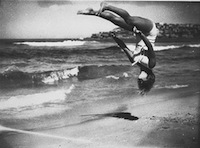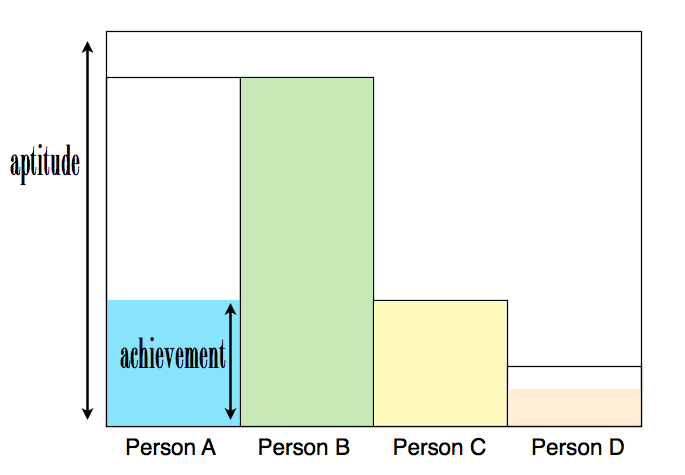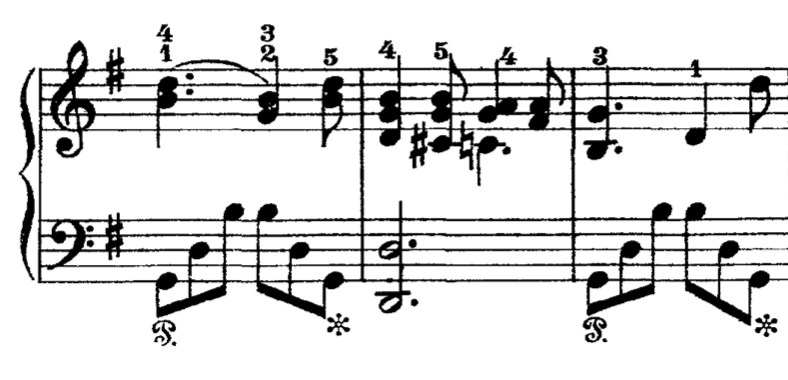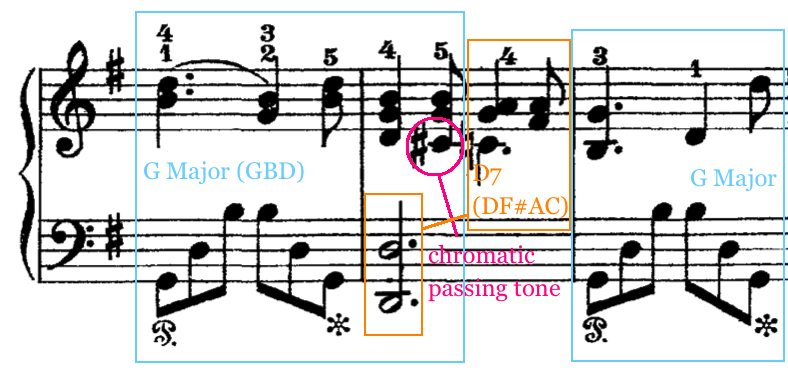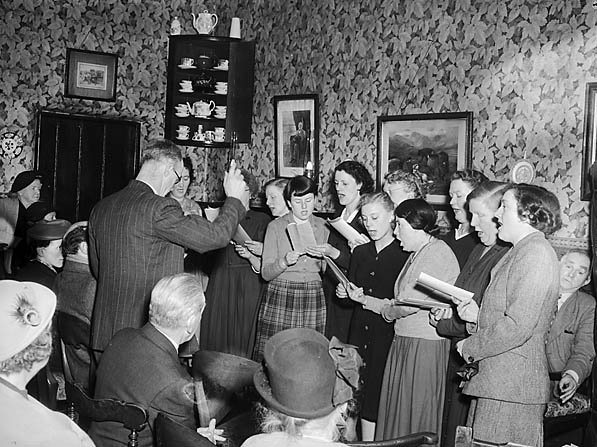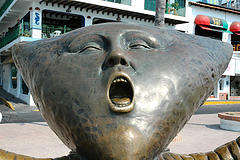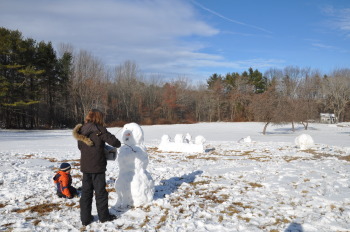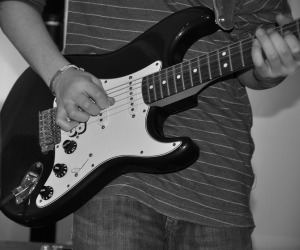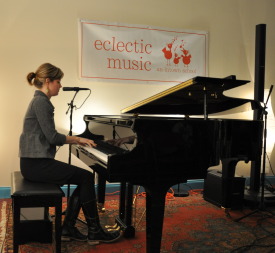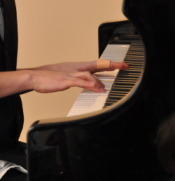This past weekend I had the pleasure of being part of two jam sessions at two wonderful dinner parties. It was nice, considering how much I've been writing about music lately, to actually play it. Jamming with other people is one of my greatest joys in life; one of my dearest wishes as a musician and educator is for those who long to be able to do it to realize how close they are to being able to!
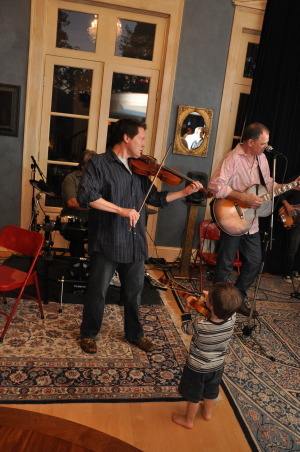 October 2010At Saturday night's party there was an exuberant nine-year-old violinist. We played some of the classical music and fiddle tunes he's been working on, and then we threw him into the soup.
October 2010At Saturday night's party there was an exuberant nine-year-old violinist. We played some of the classical music and fiddle tunes he's been working on, and then we threw him into the soup.
One of my favorite songs to jam on is Bob Dylan's "You Ain't Goin' Nowhere" - it's built on an extremely simple four-chord loop, the melody is very simple but can be embellished, and the loose country feel supports any number of layers of instruments and vocal harmonies.
"Okay! Here are your notes: D, E, F-sharp, A, and B." The D pentatonic scale. I wrote it down for him. "All of these notes will sound good. If you want, you can pick just two notes."
Many musicians have given little thought to individual notes on their instrument: where to find them, how they function together, how to create a melody. My young friend was no different, but soon located D and E and sawed merrily away as we began, lounging half on his back on the couch with his head propped up on a cushion, feet up on the coffee table. He sounded great! We sang and played several verses and choruses of the song, all of us getting more adventurous as it went on.
As the night progressed, everyone from adults to toddlers played various percussion instruments and sang. We all had a blast. The next night, my husband and I jammed with two highly competent amateur musicians on songs by Shelby Lynne, Wilco, Jackson Browne, and Three Dog Night. It was a perfect, warm, fall evening out on a friend's screen porch. Two guitars, an acoustic bass, and a djembe, all by the light of a single candle. Looking for songs that everyone knew how to play would have taken all night, but it's always easy to find common ground when you're willing to play something you know but have never played before, or something that's completely new.
Whether you're an accomplished classical musician or a total musical novice, you might find yourself standing on the sidelines instead of joining in the action. Below are some tips for joining the band.
Start shaking, tapping, or hitting something. One of the easiest ways to participate is to play percussion. Back when I was in elementary school, I'd lurk around my dad's band, whose extremely loud practices took place in the living room so they were tough to avoid (If you can't beat 'em...). My big moment was in "Day Tripper" after the guitar solo when the drums stopped and it was just a wild shake of the tambourine.
Ideally, there are some shakers and tambourines and maybe even a drum lying around. If not, the back of a guitar that's not being used makes a great drum. Raid the recycling to find empty bottles...small ones can be filled with dry beans to create a maraca, while large ones can be smacked with a hand or a stick. You can also whack the bottles themselves against your leg, the table, or the floor. Of course, body percussion (stomping, clapping, snapping, etc.) is always good.
You can keep time with the beat, but the music breathes more when you strike only on the two and four (for example, [one] TWO [three] FOUR). If you're playing a shaker, remember that you have two directions - things are more interesting when you move back and forth ("chicka chicka chicka chicka") instead of just down ("chick chick chick chick"). Experiment with rhythmic patterns to find a groove that feels right.
Sing. If it's a song you know, go ahead and sing along with the melody if it's in your key. If the range of the melody is not comfortable or you don't know the song (or someone else is dominating the melody), you can try some harmony. Try some of the techniques described in my post on harmony singing.
Viva la pentatonic. This five-note scale takes the fear out of improvisation. In a given key, all of these notes will sound good, even if you play them all at once.
Working with beginners, I like to use resonator bells if possible, which allow you to isolate the pitches that you want making it virtually impossible to hit a wrong note. Otherwise, I'll point out the notes on the instrument that are "safe." The piano is a good place to start if bells are not available.
For musicians who know how to play but aren't experienced with improvisation, I write down the notes for them which they are then able to locate on their own instruments.
To determine the pentatonic scale, play the major scale in the given key and subtract the 4th and 7th scale degrees. In other words, play 1, 2,3, 5, and 6 (and 8). This can also be done with the relative minor (play 6, 1, 2, 3, 5, 6). Do, re, mi, sol, la.
For example, if you're in the key of C major, your pentatonic scale is C, D, E, G, A in any octave.
Play root notes. If the pentatonic scale seems like Greek to you (Psych! It is Greek) back way off and play root notes. This means that for every chord of the song, you play the note it's named after.
A chord is just a group of notes. Doesn't it make sense that a chord called "G" would have a G in it? Luckily, it does. So every time the G chord comes around, you play G.
This strategy can work in a few different ways. First of all, if you're a less experienced musician this allows you to play along with a simple chord progression. In "You Ain't Goin' Nowhere," the chord sequence is D-Em-G-D. So, while the rest of the musicians play the chords you would play the notes D, E, G, D respectively.
Another use for root notes is for more experienced musicians who find themselves with an unfamiliar instrument or a bass guitar in their hands. Root notes are a great way to warm up and explore the instrument while contributing to the overall sound of the band.
A third use for the root note strategy is to familiarize yourself with a song you haven't played before. If you can recognize the chord that someone else is playing but you don't have time to get into position for it, aim for the root note. Since most pop, rock, and folk music is inherently repetitive, you'll be able to play a little more with each go-round.
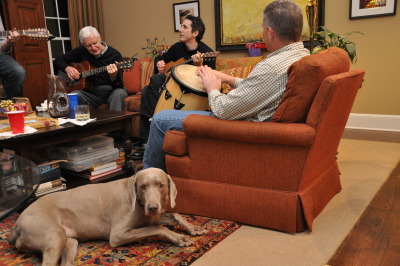 February 2010Learn the language. If you want to go beyond following along, you'll want to learn the language of music, which is basically music theory. Out of a seeming universe of possibilities, the experienced musician sees just a handful and can narrow it down to one in an instant. Here, I'm not talking about the infinite variations and permutations that enthusiastic players might cycle through as they expand the sonic vocabulary of a song; I'm talking about the structure that underpins this exploration which follows predictable, accessible rules.
February 2010Learn the language. If you want to go beyond following along, you'll want to learn the language of music, which is basically music theory. Out of a seeming universe of possibilities, the experienced musician sees just a handful and can narrow it down to one in an instant. Here, I'm not talking about the infinite variations and permutations that enthusiastic players might cycle through as they expand the sonic vocabulary of a song; I'm talking about the structure that underpins this exploration which follows predictable, accessible rules.
It is so amazing and exciting to witness a child making use of new musical knowledge within minutes of its acquisition. The advantage that many children have is simply fearlessness. I hope I have made you a little more comfortable with the idea of jamming. Your contribution to the musical soup will be appreciated and valued regardless of your level of experience! When things are really cooking, no one can tell who's who anyway.
 So, I'm now teaching middle school.
So, I'm now teaching middle school.

